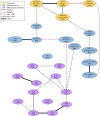Long-term sequelae of SARS-CoV-2 two years following infection: exploring the interplay of biological, psychological, and social factors
- PMID: 39618323
- PMCID: PMC11650182
- DOI: 10.1017/S0033291724002721
Long-term sequelae of SARS-CoV-2 two years following infection: exploring the interplay of biological, psychological, and social factors
Abstract
Background: Severe fatigue and cognitive complaints are frequently reported after SARS-CoV-2 infection and may be accompanied by depressive symptoms and/or limitations in physical functioning. The long-term sequelae of COVID-19 may be influenced by biomedical, psychological, and social factors, the interplay of which is largely understudied over time. We aimed to investigate how the interplay of these factors contribute to the persistence of symptoms after COVID-19.
Methods: RECoVERED, a prospective cohort study in Amsterdam, the Netherlands, enrolled participants aged⩾16 years after SARS-CoV-2 diagnosis. We used a structural network analysis to assess relationships between biomedical (initial COVID-19 severity, inflammation markers), psychological (illness perceptions, coping, resilience), and social factors (loneliness, negative life events) and persistent symptoms 24 months after initial disease (severe fatigue, difficulty concentrating, depressive symptoms and limitations in physical functioning). Causal discovery, an explorative data-driven approach testing all possible associations and retaining the most likely model, was performed.
Results: Data from 235/303 participants (77.6%) who completed the month 24 study visit were analysed. The structural model revealed associations between the putative factors and outcomes. The outcomes clustered together with severe fatigue as its central point. Loneliness, fear avoidance in response to symptoms, and illness perceptions were directly linked to the outcomes. Biological (inflammatory markers) and clinical (severity of initial illness) variables were connected to the outcomes only via psychological or social variables.
Conclusions: Our findings support a model where biomedical, psychological, and social factors contribute to the development of long-term sequelae of SARS-CoV-2 infection.
Keywords: COVID-19; HRQL; causal discovery; concentration problems; depression; fatigue; infection; structural network.
Conflict of interest statement
The author(s) declare none.
Figures


Similar articles
-
A Biopsychosocial Approach to Persistent Post-COVID-19 Fatigue and Cognitive Complaints: Results of the Prospective Multicenter NeNeSCo Study.Arch Phys Med Rehabil. 2024 May;105(5):826-834. doi: 10.1016/j.apmr.2023.12.014. Epub 2024 Jan 14. Arch Phys Med Rehabil. 2024. PMID: 38228250
-
Association of Initial SARS-CoV-2 Test Positivity With Patient-Reported Well-being 3 Months After a Symptomatic Illness.JAMA Netw Open. 2022 Dec 1;5(12):e2244486. doi: 10.1001/jamanetworkopen.2022.44486. JAMA Netw Open. 2022. PMID: 36454572 Free PMC article.
-
Post-COVID condition in patients with inflammatory rheumatic diseases: a prospective cohort study in the Netherlands.Lancet Rheumatol. 2023 Jul;5(7):e375-e385. doi: 10.1016/S2665-9913(23)00127-3. Epub 2023 May 31. Lancet Rheumatol. 2023. PMID: 37398978 Free PMC article.
-
Behavioural modification interventions for medically unexplained symptoms in primary care: systematic reviews and economic evaluation.Health Technol Assess. 2020 Sep;24(46):1-490. doi: 10.3310/hta24460. Health Technol Assess. 2020. PMID: 32975190 Free PMC article.
-
Long-Term Neurological Sequelae Among Severe COVID-19 Patients: A Systematic Review and Meta-Analysis.Cureus. 2022 Sep 28;14(9):e29694. doi: 10.7759/cureus.29694. eCollection 2022 Sep. Cureus. 2022. PMID: 36321004 Free PMC article. Review.
References
-
- American Psychiatric Association (2013). Depressive disorders. In Diagnostic and statistical manual of mental disorders (5th ed.). Washington, DC: American Psychiatric Association.
-
- Bahmer, T., Borzikowsky, C., Lieb, W., Horn, A., Krist, L., Fricke, J., … group, N. s. (2022). Severity, predictors and clinical correlates of post-COVID syndrome (PCS) in Germany: A prospective, multi-centre, population-based cohort study. Eclinicalmedicine, 51, 101549. doi: 10.1016/j.eclinm.2022.101549 - DOI - PMC - PubMed
-
- Bareket-Bojmel, L., Shahar, G., Abu-Kaf, S., & Margalit, M. (2021). Perceived social support, loneliness, and hope during the COVID-19 pandemic: Testing a mediating model in the UK, USA, and Israel. The British Journal of Clinical Psychology, 60(2), 133–148. doi: 10.1111/bjc.12285 - DOI - PMC - PubMed
-
- Baumeister, D., Akhtar, R., Ciufolini, S., Pariante, C. M., & Mondelli, V. (2016). Childhood trauma and adulthood inflammation: A meta-analysis of peripheral C-reactive protein, interleukin-6 and tumour necrosis factor-alpha. Molecular Psychiatry, 21(5), 642–649. doi: 10.1038/mp.2015.67 - DOI - PMC - PubMed
LinkOut - more resources
Full Text Sources
Miscellaneous

